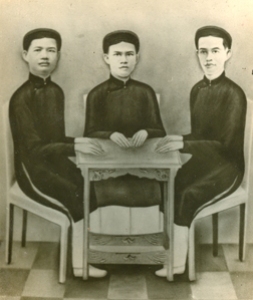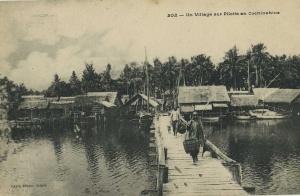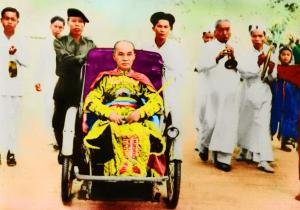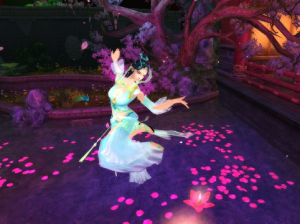I came across a “secret” report that the Indochina Section of the Far Eastern Bureau of the British Ministry of Information in New Delhi filed in 1944. It is an account of Caodaism that was written “by an Annamite who was educated in France and, later, was deported from Indochina for writing anti-French and anti-Japanese articles.”
I don’t know who this author was. However, his account is quite interesting. Much of what he wrote is by now well-known, but there are little details here and there that are fascinating. Perhaps those who know more about Caodaism than I do (and I don’t know much) are aware of everything that is in this report. Nonetheless, I think it is worth sharing.
The report opens with a passage on the origin of Caodaism and the circumstances of its birth. The author states that “Caodaism made its appearance in Cochinchina about 1927. According to Phạm Công Tắc, one of the founders of this new religion and interim ‘Pope,’ this religious movement was born from a chance event.”
“A group of Indochinese officials and intellectuals amused themselves evoking spirits by table turning. Accidentally, the spirit of ‘God’ interposed itself and announced itself as the ‘Master of [the] Universe.’ On the advice of the ‘Master” a new religion was created, giving as its aim the salvation of the Indochinese population from their present misfortunes and the unification of all the faiths into one religion which was henceforth called Cao Đài (in Chinese 高枱) which means High Altar.”
While this author says that Caodaism was “was born from a chance event,” he says that “socially speaking this movement was not accidental but coincided exactly with the decline of the nationalist movement in Cochinchina.” In particular, “the imprisonment of nationalist leaders such as Nguyễn An Ninh. . . [and] the betrayal of Bùi Quang Chiêu. . . as well as the repression against strikers had for effect the demoralization of the partisans of Cochinchinese nationalism.”
The author then states that “The state of mind found its manifestation in the orientation of nationalists towards this ‘neo-Buddhist’ religion which claimed to be able to seek the aid of gods and goddesses for solving political as well as social questions. Caodaism was therefore the issue of this desperate situation of the Cochinchinese nationalists and the fruit of political events of that time.”
I find the use of the term “Cochinchinese nationalists” in this report intriguing. Did the author mean “Vietnamese” nationalists from Cochinchina? Or did he see these people as Cochinchinese who promoted Cochinchina as a nation?
The report goes on to talk about the idea of Caodaism, its organization, the history of the movement, and its various sects. In talking about the main sect based in Tây Ninh, the author provides some interesting information about activities at the time World War II began.
“With the Japanese threat in the Pacific and the growing military strength of Germany, the political character of Caodaism declared itself. The predictions made by the “cơ” [i.e., spirit writing brush] about certain victory of the Axis powers in the coming war as well as the sanctification of the heads of these governments as disciples of the “Master,” sent on earth to reorganize the world, were whispered among the Caodaists without their leaders daring acknowledge publicly its authenticity.”
The Caodai leaders, however, did dare to seek to contact the Japanese, and this author contends that they did so through “the intermediary of a Chinese called Xoi living at Phnom Penh.”
According to this author, however, the ultimate ambition of the Cao Đài leader, Phạm Công Tắc, “was to have the Catholic religion liquidated to the advantage of his own religion and this, with the aid of Japan. His talks about patriotism or racialism were nothing but a screen.”
The author goes on to state that “At the declaration of war by France, being conscious of the dangerous consequences of his acts, [Phạm Công Tắc] for a change proposed to M. Catroux, Governor-General of Indochina at that time, to accept the mass enlistment of Caodaists for the European front, on condition that they were authorized to wear their religious costumes.”
“The strange offer,” the author states, “was rejected.”
There is also a passage here on one Cao Đài sect, the Tiên Thiên sect, that is quite interesting.
In the 1940s this sect was led by Lê Kim Tỵ. The report states that “During big ceremonies he liked to wear theatrical costumes and gave himself the title of ‘Great General of the Master.’ He professed the strict observation of vegetarian diet and the training of the ‘Ascension.’”
What was the Ascension?
“Following his advice, his followers, after a long period of fasting and meditation, tried to jump into space, from the top of towers built for this purpose, and some got their arms broken while others their legs, but they never gave up this attempt for the ‘ascension,’ pretending that their failure was due to the insufficiency of their observation of divine laws.”
The author of this report clearly did not believe in Ascension. He stated that “This ridiculous practice formed the object of public ridicule and contributed very little to the development of this sect.”
[I found this report in the Australian National Archives. See, NAA: A1067, PI46/2/4/1 Gazeteer of Indo China. Far Eastern Bureau, pages 161-168.]













This Post Has 15 Comments
Do you know why this report is at “the Indochina Section of the Far Eastern Bureau of the British Ministry of Information in New Delhi” and was filed in 1944?
The British, the Americans and the Free French (as opposed to the Vichy French government that the Germans had set up) all tried to get intelligence about what was happening in Japanese-occupied Indochina.
There was a network of three guys who provided information throughout most of the war, and I think this was the main source of intelligence to the British/Americans/Free French. They were known as “GBT,” the initials of their last names: Gordon-Bernard-Tan (Laurence Gordon, Harry Bernard, and Frankie Tan).
Then when the Japanese took complete control in March of 1945 and arrested the Vichy French officials, it became too dangerous for those 3 guys to operate. So the US started to work with Ho Chi Minh, and reportedly Frankie Tan and HCM went into Vietnam and sent information back to US officials who were based in southwestern China at that time.
However, the British, Americans and Free French must have looked for other sources of information, and that is probably where this report came from. I don’t know who this “Annamite who was educated in France and, later, was deported from Indochina for writing anti-French and anti-Japanese articles” was, but he provided helpful information, as I’m sure the British wanted to know who in Vietnam was close to the Japanese.
Thank you so much!
i don’t know what is the “table turning”. Please tell me. Thank you very much!
“Table turning” or “table tipping” refers to various techniques that were used to communicate with spirits. Look at the picture of the three men sitting at a table with their hands on the table. That’s what they are doing.
Sometimes people would use a special object (like a Ouija board – http://en.wikipedia.org/wiki/Ouija) that had letters of the alphabet on it, and when people sat around the table, the spirit they were trying to communicate with, would move their hands over letters in order to spell out a word.
At other times, people would hold the edge of the table and lift the table up and down so that it made a sound. Each sound represented a letter in the alphabet, and they would spell words that way.
So for a spirit to “write” the word “bắc” for instance, the table would have to move up and down 4 times (to get to “b”), and then 2 times (for “ă”, and them 5 times (for “c”). I don’t know how/if they indicated tones.
a, ă, â, b
a
a, ă, â, b, c
Table turning was part of a movement in Europe and North America in the late nineteenth and early twentieth century called “Spiritualism.”
http://en.wikipedia.org/wiki/Spiritualism
I’m pretty sure “Cochinchina nationalists” refers to the Cochinchina people who want independence for Cochinchina as a nation set apart from Annam and Tonkin. There was a subtle movement for the independence of Cochinchina led by Đảng Lập Hiến the Constitutionalist Party whose members and founding members were pure Cochinchinese (Dr. Nguyen Van Thinh, Sir. Van Giao, Sir. Bui Quang Chieu,…). There was a protest in Saigon for the independence of Cochinchina, according to Brett Reily’s research.
The motivation for Cochinchina people demanding independence for Cochinchina only could be that they needed Cochinchina to be independence first so that they would planned to help Annam and Tonkin and the entire Indochina Federation become independent (as Dr. Thinh’s goal and strategy) , or, they simply just wanted independence for their own sake. Well, as that time except for the elites, ordinary people didn’t have a clear definition of the “Vietnam as a whole”. They were still influenced by the Dang Trong – Dang Ngoai era (after Emperor Gia Long unification, Minh Mang just messed shit up making Cochinchinese and Annamese dislike Tonkinese : the Cochinchinese and Annamese court officials formed a group called Trung Nam Hội as they fed up with Tonkinese butting in too much into the court activities, and Minh Mang was famous for favoring Tonkin officals while disliking/being cautious towards Cochinchina. So, unification was just ”territorial unification” and people was ok with it since at least the Hue court divided the new unified Dai Nam into 5 official territorial area (Nam kỳ – Tả kỳ – Trực Kỳ – Hữu kỳ – Bắc kỳ) ) . Thus Cochinchinese already subtly considered themselves a separated nation , all they needed then was that nation to be independent, the Tonkin and Annam might be able to take care of themselves if they wanted to. If the Cochinchina succeeded, and the other 2 wanted to follow its step, it as a nation would offer help but without interference.
Thanks for the comment!! I see that I wrote this back in 2013. I don’t think I knew about Cochinchinese nationalists then. I remember coming across an article from the late 1940s somewhere (the journal Pacific Affairs?) that talked about Cochinchinese nationalists, and that made me realize that people at the time recognized that there was such a group of people. I remember wanting to know more, and now this comments reminds me that I still need to do that. . .
It could be suppressed by the media, such movements laid the foundation for the establishment of the State of Vietnam and later RVN though. You know of the Republic of Cochinchina right? PM Nguyen Van Xuan founded the Provisional Central Government of Vietnam after the suspicious death of Dr Thinh, who then was the President of Republic of Cochinchina. Sir Nguyen Van Xuan was the former Deputy PM of ROC; his new government Chánh phủ lâm thời VN (PCGVN) borrowed ROC’s strategies and constitution. In other words, it was a just new wine in the old bottle. Then, after successfully convinced PM Xuan to merge the PCGVN into the one State of Vietnam, Emperor Bao Dai built his State of Vietnam following the blueprint of PCGVN. One more interesting thing about the movement of Cochinchine nationalist : Sir Nguyen Phong Tan was a fierce voice of the movement and was arrested by the French, then was assassinated in France by an opposite force. (Viet Minh ?) The Army of Cao Dai, Army of Hoa Hao Buddhist, the Binh Xuyen led by Sir Le Van Vien, all were part of the movement for the independence of Cochinchina. Sir Le Van Vien once said to Nguyen Binh (a Viet Minh personnel sent from Tonkin by Ho Chi Minh) when Binh asked the 3 armies to join VM and be led by him : “We respect you and your party, but there will be no such thing as the Tonkinese be the big brother of the Cochinchinese. It’s a big no from us.” (I killed Nguyen Binh – Memoir of Tran Van Tuc, 1972). The movement was still around during RVN, under both President Diem and Thieu, but was stronger under Diem’s reign. General Tran Van Don who threw a coup against Diem was known to said “There will be no such thing that 1 millions of Tonkinese (nguoi Bac Ky) ruling the entire land and people of the Cochinchinese (nguoi Nam Ky)” (Witness of Vietnam, Tran Van Don). The CIA was fully aware of the movement as well : In CIA’s South Vietnam’s constituent assembly a preliminary appraisal, the US reported a subtle to the public but clear to the internal forces movement that Cochinchina nationalists were struggling to win back the power against the government with the majority of Tonkinese migrants backed up by the US.
I would say the movement was a real continuous thing until the final fall of Saigon.
Thank you for sharing this!! It’s very interesting. I didn’t know about this, but it all makes sense.
Yea, I remember looking at documents from the late colonial period, the State of Vietnam, and South Vietnam and they were all so similar. It was as if the same stationary company produced them all (probably did), and just changed the name on the top of the pages when a new government came to power. So, what I’m saying is in that environment, it makes sense that what Cochinchinese were doing in forming a government was continued (or taken over) by the State of Vietnam, etc.
I see a brief summary of that document here: https://library.usask.ca/vietnam/index.php?state=view&id=981
It mentions a possible alliance between Southerners and Catholics. I was wondering about that. Were any of the Cochinchinese nationalists Catholic? Why would they ally with Catholics?
Thank you for the respond! I have a feeling this topic has been avoided and was suppressed or ignored. I believe this movement was so serious and widespread that it affected many consequent events in the latter era. It was definitely a forgotten epic past of the Cochinchina. There are a lot of events, mysteries and secrets that have never been widely discussed. I have collected my knowledge through the witnesses memoirs, researches , interviews from the involved personnels then all of the sudden I just see the big picture and it ultimately clear all my doubts regarding the society, idealogy , the wars from colonial and post colonial era.
You can find the PDF file of that document on the CIA archive :
https://www.cia.gov/readingroom/docs/CIA-RDP79T00826A001400010007-3.pdf
My opinion regarding your question is that I don’t think there was an alliance between Catholics and the Southerners.
During the French colonization, there was neither conflict nor clear alliance between Southern Catholics and non-Catholics. However in the North, I believe there was. Ta Van Phung asked a French general (I don’t recall his name I’ll comeback later with the name) to form an ally with his army to rebel against the Nguyen and establish a nation of Tonkin (separating from the Nguyen’s rule). At that time, in both Tonkin and Cochinchine the French were also seen as Catholics, so Ta’s offer to the general was a clear incentive of forming an ally between the Catholics and the Tonkinese. I came to this conclusion by adding pieces of data together just like 2+2=4, I still need more data to back this up though.
During post colonial era, this trend was stronger in the North. I’m sure you know of the Phat Diem town. Except for the VM followers and the people in the VM controlled area, people in the North who cared about politics pretty favored Catholics as they saw the potential of the French in helping them become independent from the Nguyen’s rule. The majority of migrants to the South after 1954 were Catholics (Joseph G Morgan, The Vietnam Lobby; Nghiem Ke To , Viet Nam Mau Lua). There were, and still are towns in the North which were fully Catholics, you’ll never find one in the South.
For the Southerners, I think they didn’t really care about the Catholics or Protestants (Southerners who followed Christianity) since all of them (Christians and non-Christians) already lived in harmony. There might be some dislike towards the Catholics since they were seen as the French “surrenders/followers” but it was just that. Yes, There was mutual support between Southern Catholics and the Southerners for the sake of Cochinchina : Sir Truong Vinh Ky, Empress Nam Phuong’s father, Sir Nguyen Huu Hao donated a massive amount of financial means to the public services, Empress Nam Phuong herself donated to the independent movements in Cochinchina , Annam and Tonkin, Sir Bui Quang Chieu – a member of the Constitutional Party was also a Catholics. However, when it came to an official political alliance, no, I don’t see any alliance between Catholics and the Southerners during both pre and post colonial era.
The relationship between Catholics and the Southerners during the RVN was a different story as nearly 1M Catholics migrants and the US entered the game. It was tense and it forever changed Catholic in Southern Vietnam till today.
Thanks for this!! I don’t have knowledge about this topic. However, your statement that “this topic has been avoided and was suppressed or ignored” is one that applies to a lot of topics pertaining to South Vietnam. Is your plan to write something about this?
Hi Dr. Liam. I’m sorry for my late response. I did write something focusing on Cochinchina before, then abolished all. I’m planning to launch another project though, I’m studying more of Cochinchina religions as well (probably will include this topic in my future project), I’m quite sure there were something happened that related to all the newly establishment of many religions in Cochinchina within the timeline from 1920-1954, there were coincidences among ideas of and events happened among those religions. For example, the similarities in the death of Huynh Phu So and H.H Minh Dang Quang – the founder of Khat Si (乞士) Buddhism.
This might be just my hypothesis and I could be wrong, but I’m still holding the belief that one of the reasons (besides the political goal) that the US entered Southern Vietnam and made Ngo Dinh Diem – a Northern Catholic politician – president , also conducted a campaign called Follow Christ to the South (part of the Passage to Freedom campaign) to bring nearly 1M Catholic Tonkinese migrants to Cochinchina was to eliminate/ reduce the influence/disturb the growth of those religions. With my current limited understanding and ignorance, I still have a lot to research. Hopefully I can make it work.
The Vietnamese March-to-the-South was completed around 1860s when the French started their agression .
Cochinchina was cut off from Vietnam and made French territory .
Tonkin and central VN were to become protectorates .
The French conquest would have been much
difficult without the helping hand of fifth column of VN Catholics and other non Catholic shills , tẩu cẩu , running dogs .
In Cochinchina, they were given large stretches of land to become đại 田 điền. 主 chủ
The most famous ones were : Lê phát 達 đạt
Bao dai’ s father in law , Dô huu Phuong .
Most members of the Constitutionalist Party were members of that gentry and zealous supporters of French colonization .
They were for some much assimilated to French culture : Ng v Xuân was French army general , the pair Ngô dình Nhu and wife talked with each other in French.Dô huu Phuong , a famous anti Cân Vuong fighter
was informal mayor of Chinatown
( Cho Lon ) .
The VN Catholics were the main and fiercest supporters of the colonists .
Villages like Phát Diem were the models of later “strategic hamlets “and built on the periphery of anti Fr. guerilla strongholds
The tentative to create an independent
R. of Cochinchina has analoguous precedents : splitting of Ireland , creation of Panama , the colonialists ‘usual trick to divide and rule , or winning time
The Bắc Kỳ Di Cư 1954 migration to South
of nearly 1 million northern refugees ( 90%
of them Catholics have a precedent : the Boers ‘ great Trek .They lost their first homeland to the British and went nearby to take over other people ‘s land . The 1954 Geneva accords which were only separation-of -forces pact did not split VN in half as clamored , they on the contrary tacitly recognize Viet minh right to replace French rule over all of VN .The US and Catholics did a Great Trek or Panama trick against the Vietminh ; while the latter conforming to the accords withdrew their troops to north VN , south VN was occupied by US-
VN Catholics , creating a imposter Republic of± VN headed by Ngô dình Diêm who would provide an alibi for US intervention, signing treaties of alliance with the USA .
South VN was to become a”bastion of the Free World “(sic ), a stepping stone to US main target, the great prize of q China
By the way, regarding “ the ultimate ambition of the Cao Đài leader, Phạm Công Tắc, “was to have the Catholic religion liquidated to the advantage of his own religion and this, with the aid of Japan. His talks about patriotism or racialism were nothing but a screen”, I agreed Pham Cong Tac ultimate goal was to promoted his own idea of Caodaism and make it a great religion , but “ to have the Catholic religion liquidated” was not true at all. Pham Cong Tac was baptized as a baby and his father was a Catholic. He was Catholic or at least a Catholic supporter! Pham was the one who promoted the Jesus and “made” him one of the main holy figures, he followed the Vatican’s structure to organize his sect. The early Caodaism was not really favor Western religious philosophy, until Tac rose to influence and dominance. In the “Lich su cua quan phu Ngo Van Chieu” published in 1932 , the author implicated Pham cong Tac and his followers was trying to deny the fact that Ngo Van Chieu was the first founder of the religion and Pham’s teaching was not the original given from the Maha Caodai (Cao Dai Bo Tat Ma Ha Tat). The main sect aka Pham cong Tac’s sect until today remains the most powerful sect and is more leaning or closer to Catholicism than the other sects.